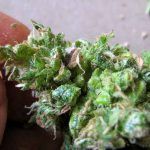The WhiteFly Plague
The whitefly is a small, white insect, but what truly matters is that it’s a devastating pest for marijuana and other plant species. No matter you’re here for prevention or to solve an existing issue, don’t worry. We’ll guide you through everything you need to know about whiteflies and how to effectively eliminate them.

How to recognise the whitefly?
The whitefly is a small flying pest, approximately 1-2 mm in size, which usually attacks the leaves of various plants. There are several species, but the most common in crops are Bemisia tabaci and Trialeurodes vaporariorum.
They are found in a fixed form on the underside of leaves, and are recognisable because they look like small white flies standing still, as they are sucking. They are attracted by the yellow and light green colour of the plants, as well as by their properties. These flies suck the sap from the leaves, weakening them and leaving a sticky substance called honeydew, which favours the growth of fungi such as fumagina. Whitefly infestation can cause yellowing, weakening and leaf drop.
Visible Plant Symptoms
Whitefly infestation is easily identified by several characteristic symptoms on plants. Affected leaves show a gradual yellowing starting at the tips and edges. In addition, as mentioned above, the plants may develop honeydew, which can lead to fungus. Over time, another symptom of a more advanced infestation is that leaves weaken, wilt and may drop prematurely, negatively affecting the overall health of the plant and its ability to photosynthesise.
Impact of Whitefly on Photosynthesis
Whitefly negatively affects photosynthesis by feeding on plant sap, which reduces the amount of nutrients the plant can use to generate energy. By interfering with energy uptake, it weakens plant growth and production, even leading to plant death.
Reproduction of the whitefly
Reproduction is by eggs, which are laid on the underside of leaves, in numbers of approximately 180 to 200, yellowish-white and very tiny in size. To the naked eye it looks like a small amount of white powder.
It takes 20 to 24 hours from the time the eggs are laid to the hatching of the individual. There are four larval stages from the egg to the adult individual.
First instar: The larva is 0.25 mm in size. This larva has its mouthparts in the plant tissue in order to feed on it.
Second instar: The larva is about 0.4 mm in size, and the appearance of legs can already be seen.
Third instar: When the larva is 0.5 mm in size and transparent in appearance.
Fourth instar: Organs such as eyes appear and it begins to increase in thickness and size.
After these four larval stages, the whitefly flies immediately take flight. The larval stage lasts for one month. Suitable conditions are necessary for full development. The whitefly has a sucking mouth organ with a stinging extension which causes a variety of damage to the plantation by sucking sap from the plants and developing fumagina.
Whitefly Modus Operandi
The crops most affected by this insect are: tomato, pepper, cucumber, bean, tobacco plants. Damage begins when the fly settles on the underside of the host leaf, and both adult and larval stages begin to feed on it, deteriorating its growth. Due to its ease of moving from one plant to another, and introducing its mouthparts, it can transmit viral diseases and even through its excrement, which forms a sticky film and causes the development of fungi, triascolcer is being tested to eliminate the substances.
What is the predator of the whitefly?
A predator used in biological control is an insect that feeds on the pest affecting our plants, without causing damage to the plants themselves. These predators naturally control the pest population, maintaining a balance in the ecosystem and helping to protect the crop without the use of insecticides. The most commonly used to eliminate the whitefly is the Encarsia Formosa fly, which is very small, barely reaching 1 mm in size.
It is black except for its yellowish abdomen, two transparent wings and antennae. It feeds on whitefly larvae and the sticky, sweet substance it leaves on the underside of leaves.
This parasite has a stinger which it inserts into the larva and deposits its egg. After about 15 days, an Encarsia Formosa fly will hatch instead of a whitefly. We will get rid of the whitefly, and this parasite will migrate to areas where other larvae are located to parasitise again.
Encarsia requires a temperature of 25 to 27C and a relative humidity of 50 to 60%, with incidence of light, to have a more active parasitic activity.
These parasites are usually sold in cardboard stickers but in larval form. Depending on the density of whiteflies invading the crop, as well as the density of the crop, more or less of the predatory parasite will be needed. In the first weeks they are usually applied in larger numbers, about 10 parasites per m2.
After the parasite larvae have been released, it is important to check whether Encarsia formosa fly invasion has started. To check this, the colour of the parasitized larvae should be observed: if they turn dark, this indicates that they have already been attacked by Encarsia formosa, confirming that the parasitization process is underway. This colour change is a clear sign that the larvae are being effectively controlled.
Other whitefly predators:
Eretmocerus californicus
Macrolophus caliginosus
Paecilomyces fumososeus
Effective Home Remedies for Whiteflies
Garlic and chilli infusion: Boil several cloves of garlic and a couple of chillies in water. Allow to cool, strain and sprinkle on plants. This remedy acts as a natural repellent.
Potassium soap: Mix potassium soap with water and spray the leaves. The soap breaks down the exoskeleton of whiteflies, eliminating them safely.
Peppermint infusion: Peppermint has repellent properties that deter whiteflies. Prepare an infusion and apply it directly to the affected plants.
Sticky traps: Place yellow sticky traps near plants to catch flying whiteflies.
Insecticide Recommendations for Whitefly Insecticides
For safe and effective whitefly control, potassium soap is recommended, which eliminates the insects without damaging the plants. Another natural option is Neem oil, which is ideal for attacking both adults and eggs of whiteflies. Both products are safe and environmentally friendly. They are also suitable for many other pests of Cannabis and other plant species. These products can also be applied before having the pest, as a preventative, and in this way avoid future problems.
And this is all about the whitefly plague and how to control it, if you liked it, follow us on social networks and on our mailing list. Also, you can see the insecticides we have available for you in our online shop. Here we leave you with a video where he indicates the biological control against the whitefly, the video defines the insect that we deal with today, how to recognize it, and you will see it in such a way that from now on you will not miss any when checking your crop. To learn more about growing marijuana, visit our marijuana growing section.
Founder of Experiencia Natural, creative and entrepreneur, designer, master in grower and marketing. For a normalization of all plants and substances, giving priority to patients and users.















